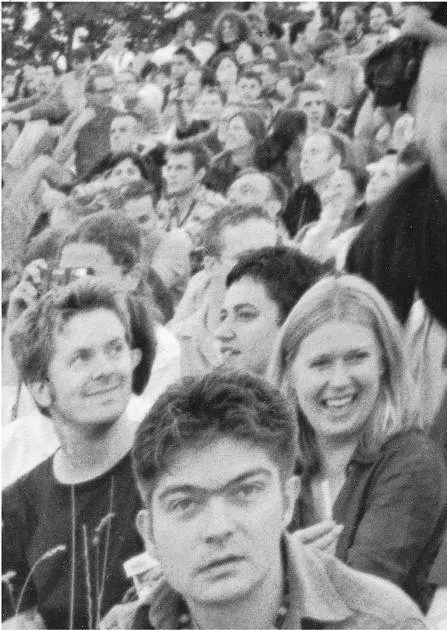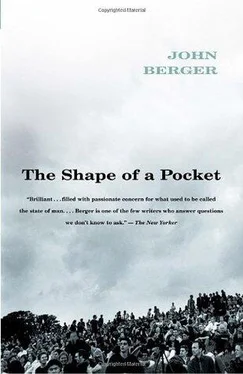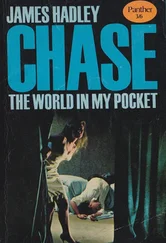‘I did not think,’ said Antigone, ‘your edicts strong enough
To overrule the unwritten unalterable laws
Of God and heaven, you being only a man.
They are not of yesterday or today, but everlasting,
Though where they came from, none of us can tell.’
The poster looked down on the streets of Paris as might a ghost. Not the ghost of the man with tousled hair, nor Géricault’s. But the ghost of a special form of attention, which for two centuries had been marginalised but which every day now was becoming less obsolete. This is the second finger.
Pinched, what do we do? Wake up perhaps.

20 An Apple Orchard (An Open Letter to Raymond Barre, Mayor of Lyon)
Monsieur Le Maire,
I have been asked to write to you whilst you are dreaming. Not an easy task. Dreams proceed in their own way, have their own manner of jumping and sidestepping and throwing the dreamer (why in English are nightmares called night mares?), dreams have their own predilection for not saying things, their own form of mystery, and their own intimate and inexplicable relation with what may be true. On the one hand I have to tread carefully so as not to wake you up, and, on the other hand, I have to avoid straight lines, otherwise you will stop dreaming. In a dream nothing is insignificant.
The prison of St Joseph was built in Lyon between 1829 and 1831. It faces the River Rhône just before it is joined by the Soane.
Forty years later, the second prison of St Paul was built beside St Joseph’s. Hexagonal in form and using new construction techniques with metal, St Paul’s was planned for women. It had four long dormitories instead of cells.
Today, the two buildings, connected by an underground tunnel, serve as the city’s principal Maison d’Arrêt for prisoners awaiting trial or serving short sentences. Where the dormitories once were, cells have been installed. The prison complex is known today, by those who are familiar with it, as La Marmite du Diable. The Devil’s Cauldron.
Most theories about, or visions concerning, prisons tend to be false, because the practice defies everything, or anything, which has been thought out. The containment, the way the spaces are interlocked, the hours, the codes, the isolation and the overcrowding — these things together produce the unpredictable, before which some inmates are more vulnerable than others, but before which all who find themselves there, inside — including the warders and even the Director — are, at certain moments, powerless.
Prisons are planned and manned in such a way that supervision — electronic and otherwise — maintains a maximum control over the imprisoned at all times. Yet in practice the uncontrollable is constantly present. There is no other institution on earth where the uncontrollable can explode so quickly.
On the far side of desperation, men become either wise or beyond control, beyond the control of any system or of themselves. The uncontrollable is incarcerated in the same cell as wisdom, behind the same door of desperation.
Sometimes the uncontrollability enters a prisoner’s own body. It is this which ‘explains’ the frequent cases of self-mutilation. Men damage themselves because the prison and its uncontrollability have already penetrated their bodies. Nothing stops nothing. The mutilation is not to the self, but to what has penetrated that self before the swallowed spoon, the swallowed broken glass, the swallowed knife.
Who was Delandine? Perhaps it was a nickname. What is certain is that there’s a street named after her, the narrow short street which separates the two prisons.
After midnight and at weekends the Rue Delandine, which in the daytime is usually deserted, is full of people who have come to talk, to fling words over the high walls, to their prisoners inside. Certain shouts come back like boomerangs. I love you too! At another window: Why don’t you fuck off and let me be!
The visitors come to the Rue Delandine after midnight because the noise of the city traffic has diminished by then, and it’s easier to hear and be heard. On Monday nights there’s often nobody there. On Mondays the silent street becomes full of something else. Stay dreaming, sir, and you may feel it. Behind the walls, across the narrowest gully, and then very close behind the second walls, on both left and right, there is a sense of stacked sleep, and, confronting that sleep, almost touching it, the total indifference of the hewn stones, iron bars, and laid bricks. A strange congruity, even harsher than that of the earth around corpses.
What kind of building would you say, sir, houses the most dreams? School? Theatre? Cinema? Library? Intercontinental Hotel? Discothèque? Mightn’t it be a prison?
First, the modern prison was founded on a set of dreams. The dream of Civic Justice. The dream of Correction. The dream of a City of Civic Virtue.
And then there are the dreams dreamt now, each night. Dreams include, of course, nightmares and insomniac terrors. Under certain circumstances the insomniac may lose, like a dreamer, his sense of physical time and place.
Inside the walls, on the other side of the narrow gullies, there is the great perennial dream of Escape. Amongst the screws there is the perennial nightmare of a Prisoners’ Revolt.
Further, there are the endless small dreams. The dream of the sea — the Rhone is the length of a garden away and the pigeons, who shit on the wire netting, fly over the river. The dream of taking the TGV to Paris. It leaves every hour and its tracks are even nearer than the Rhone. Dreams of privacy. These are as much about time as space. The dream of private time. Choosing a date — say Saturday May 6th — to do something one has chosen for oneself! On Saturday, I’ll go and see the brother-in-law in Bapaume. Or, on Saturday, I’ll go to the cemetery in Clamart and there I’ll find the vodka bottle under the flowers on my friend’s grave and I’ll drink to him. (He too was in another kind of prison for twenty-seven years.)
The dream of women. The dream of open doors. The dream of Saturday nights. The furious dream of putting an end to everything. The dream of no more mistakes.
And, finally, there is a dream which may be the most persistent and ubiquitous of all. In St Joseph’s isolation block, in the prétoire where punishments for insubordination are handed out twice a week, in the showers, in the exercise yard under the wire netting with garbage where the stars might be, walking on all fours, sitting before the television, on the stairs, in the mitard , alternating between insults and silence, day and night, year after year, men dream in flashes of their thousand mothers, many of whom are lost or dead and, who being so, find their own way instantaneously through the prison walls.
Once inside the Maison d’Arrêt, some of these mothers tell stories to their children. Many many stories. Here, sir, is one.
Once there was a man who, every morning, picked up a bread-knife and cut off ten centimetres from the loaf of bread he was holding, and threw this chunk away, before cutting another slice for his own breakfast.
The man did this because every night mice had nibbled a hole from the centre of the loaf. Each morning the hole was about the size of a mouse. The house cats, although they hunted moles, were strangely indifferent to the grey mice who ate the bread, or perhaps they had been bought off.
This had been the state of affairs for months. Many times the man had written down mousetrap on a shopping list. And many times he had forgotten, perhaps because the shop where the villagers once bought mousetraps no longer existed.
Читать дальше













